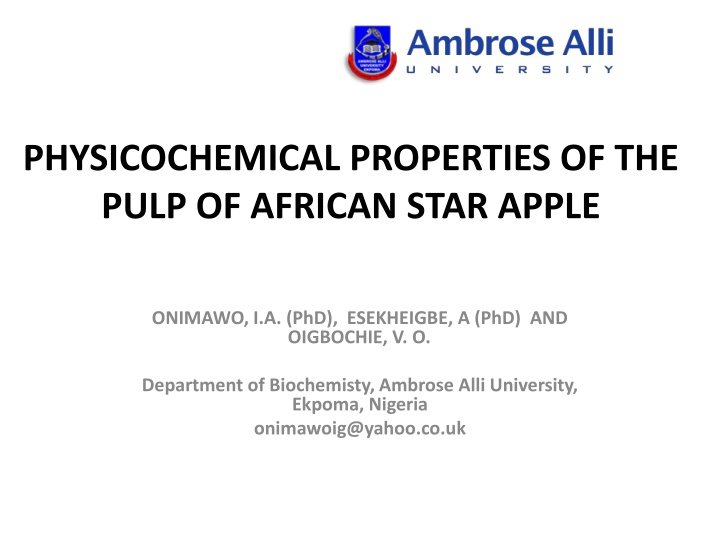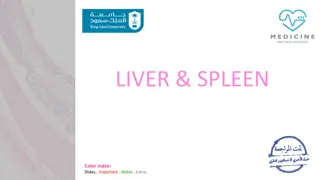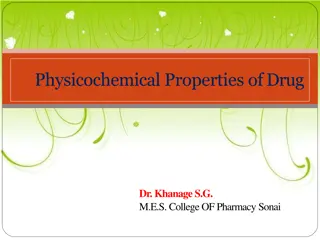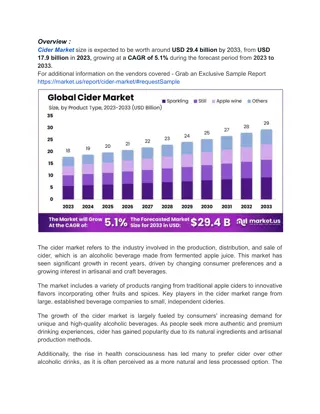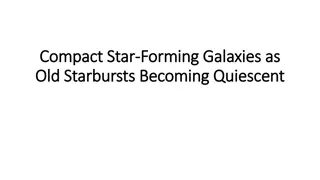PHYSICOCHEMICAL PROPERTIES OF THE PULP OF AFRICAN STAR APPLE
African Star Apple, also known as Agbalumo or Udara, is a tropical fruit with various culinary and medicinal uses. This study explores the physicochemical properties of the pulp, including composition analysis, phytochemicals, and antinutrients.
Download Presentation

Please find below an Image/Link to download the presentation.
The content on the website is provided AS IS for your information and personal use only. It may not be sold, licensed, or shared on other websites without obtaining consent from the author.If you encounter any issues during the download, it is possible that the publisher has removed the file from their server.
You are allowed to download the files provided on this website for personal or commercial use, subject to the condition that they are used lawfully. All files are the property of their respective owners.
The content on the website is provided AS IS for your information and personal use only. It may not be sold, licensed, or shared on other websites without obtaining consent from the author.
E N D
Presentation Transcript
PHYSICOCHEMICAL PROPERTIES OF THE PULP OF AFRICAN STAR APPLE ONIMAWO, I.A. (PhD), ESEKHEIGBE, A (PhD) AND OIGBOCHIE, V. O. Department of Biochemisty, Ambrose Alli University, Ekpoma, Nigeria onimawoig@yahoo.co.uk
INTRODUCTION African Star Apple (Chrysophyllum albidum), an indigenous plant is an edible tropical fruit, which is classified as a wild plant, and belong to the family Sapotaceae. The fruit which is known as Agbalumo by the Yorubas and the Igbos call it Udara (Keay, 1964) is seasonal and glaborous when ripe, ovoid to subglobose, pointed at the apex and up to 6centimetres long and 5cm in diameter. The skin or peel is orange to golden yellow when ripe and pulp within the peel may be orange, pinkish, bricked or light yellow (Dauda, 2014). The fruit grows naturally in the forest habitat of parts of Africa extending from Sierra-Leone through Guinea, Sudan to East African Countries such as Kenya, Uganda. It is distributed in all forest types (low and tropical rain forest) in Southern Nigerian and also in compounds and outlaying farms in most villages, in parts of South- Western Nigeria.
Introduction contd The tree mostly flowers between the months of April and June and fruits between December and March (Dauda, 2014). Fruits generally are not only consumed fresh but also used to produce jam, jellies, stewed fruit, marmalade, syrup and several types of soft drinks. It is also used for medical purposes . The leaves and seed in pharmaceuticals. Some of the trees are also valuable for ornamentation as an ever green broadleaf plant (Islam, 2002).
Chemical Analysis They fruits were divided into two portions .One portion was used for the determination of the moisture and ascorbic acid contents. The other portion was dried in hot air circulating oven (Gallenkamp DV330) at 650C to a constant weight for (18-24h).The dried samples were ground into powder using an electric blender with steel blades and stored in screw capped containers at 4-6oC. pending analysis Proximate composition was determined by standard procedures (AOAC, 2000). The energy value was calculated using the Atwater factors of 4, 9, and 4 for protein, fat and carbohydrate, respectively. Samples solutions were analysed for some metals with different hollow cathode lamps for calcium (Ca), iron (Fe), and zinc (Zn) using an atomic absorption spectrophotometer (Jenway, FPSP 210) while sodium (Na) content was determined using a Flame Photometer (Perkin Elmer, Analyst A, 800).
Chemical Analysis contd Phytochemicals and antinutrients were determined using the aluminium chloride colorimetric assay method (Zhishen et al., 1999) flavonoid content. Total phenolic contents were measured by the Folin Ciocalteau method (Singleton et al., 1999). Tannin was determined by the vanillin-HCl method of Price et al. (1978). Phytate was estimated according to Wheeler and Ferrell (1971). Oxalate was analyzed by the procedure described by Ukpabi and Ejidoh (1989). Total alkaloids were determined by the spectrophotometric method of Shamsa et al. (2008) while saponin composition was estimated using the gravimetric method .
Sample pH was determined in triplicate at room temperature using a pH Meter. Three point calibration was accomplished employing pH 7.0, 4.0 and 2.0 buffers (Fischer Scientific). Titratable acidity was determined by titration to pH 8.1 with 0.1 M NaOH solution and calculated as grams of citric acid per 100 g of sample (AOAC, 2000). The Total Soluble Solids (TSS) for the pulp was determined in Degree Brix using a hand Refractometer (Alago, Tokyo model Leica 10431) with a scale of 0-50 degree Brix. The anthrone method as modified by Kumar et al.(2012) was used with glucose standard curve serving to estimate the concentration of total sugar in the sample. Vitamin C (ascorbic acid) was determined by indophenol (DCPIP) titrimetric method as described by Mau et al (2005). The colorimetric method of AOAC (2000) method was adopted which measures the absorbance of 620nm of the colour that results from the reaction between vitamin A and SbCl3. The data obtained in this study are presented as mean standard deviations which were computed with the aid of a statistical software (IBM SPSS, version 23).
RESULTS Table 1: Proximate Composition of African Star Apple Fruit Pulp Moisture (%) Ash (%) Protein (%) Fat(%) Fibre(%) CHO(%) 85.38 0.06 0.41 0.10 0.76 0.03 4.32 0.14 0.57 0.06 8.46 0.13 Results are presented as Mean SD of triplicate determinations; CHO = carbohydrate Table 2: Mineral Composition of African Star Apple Fruit Pulp Calcium (mg/100g) (mg/100g) Iron Sodium (mg/100g) Magnesium (mg/100g) Potassium (mg/100g) 10.19 0.70 2.90 0.69 102.85 0.59 40.26 346.17 2.46 0.44 Data is presented a Mean SD of triplicate determinations
Table 3: Phytochemical/Anti-nutrient Composition of African Star Apple Fruit Pulp TA (mg/100g) (mg/100g) (g/100g) (g/100g) TP PHY OXA SAP (g/100g) ALK (g/100g) FLA (g/100g) 8.31 1.08 5.57 0.92 0.08 0.01 1.25 0.03 9.38 0.17 26.79 0.16 16.10 0.03 Data is presented as Mean SD of triplicate determinations, SD = Standard deviation, TA = Tannic acid, TP = Total phenol, PHY = Phytate, OXA = Oxalate, SAP = Saponin, ALK = Alkaloid, and FLA = Flavonoid. Table 4: Chemical Composition of African Star Apple Fruit Pulp pH TTA (%) (g/100g) TDS TS (g/100g) Sugar (g/100g) Energy (MJ/100g) 2.42 0.04 Analysis was done in triplicate and presented as Mean SD of triplicate determinations; TTA = Total titrable acidity, TSS = Total soluble solids, TS = total solids 0.08 0.01 7.62 0.02 23.33 18.27 0.25 206.18 1.01 0.18
DISCUSSION The pulp had appreciable concentrations of some minerals. High concentration of potassium (346.17mg/100g) and a lower level of iron (2.90mg/100g) were observed in the pulp. Thus was in agreement with the report of Adepoju (2009) who asserted that C. albidum fruit pulp was very high in potassium, calcium, and phosphorus, zinc, manganese and copper. The Chrysophyllum albidum varieties can be good source of potassium, calcium and phosphorus, which are needed for electrolyte balance, neurotransmission, development of strong bones and teeth (Roth and Townsend, 2003).
Anti-nutrients such as phytate (0.08g/100g) and oxalate (1.25g/100g) were found to be low in the pulp of the seed. However saponin was found to be relatively high (9.38g/100g). Adepoju and Adeniji (2012) had earlier reported a phytate range of 0.037 0.062mg/100g for some Chrysophyllum varieties which were however lower than that observed in this study. The fruit pulp of Chrysophyllum albidum can be said to contain low levels of some anti-nutritional factors like phytate and oxalate, and consequently the adverse effects of these antinutrients would be minimal upon the comsumption of large quantity of the fruit. The fruit contained higher proportions of phytonutrients like flavonoids which has been known to play the role of antioxidant that aid in the scavenging of free radicals. Hence, the fruit pulp could be considered to be very nutritious (Takruri and Dameh, 1998), and its consumption should be encouraged. Vitamin C is highly sensitive to a lot of conditions such as heat, light, oxygen, pH. This study shows that the African Star Apple has an average value of 40mg/100g which is higher than the 12mg/100g reported by Dauda (2014) for Chrysophyllum juice. Vitamin A is known to serve as an antioxidant, enhance good vision, and possesses an anti-aging activity. That the pulp is rich in vitamin A (246.33mg/100g) is a good quality of the African Star Apple. CONCLUSION: Consumption of African star apple is encouraged
